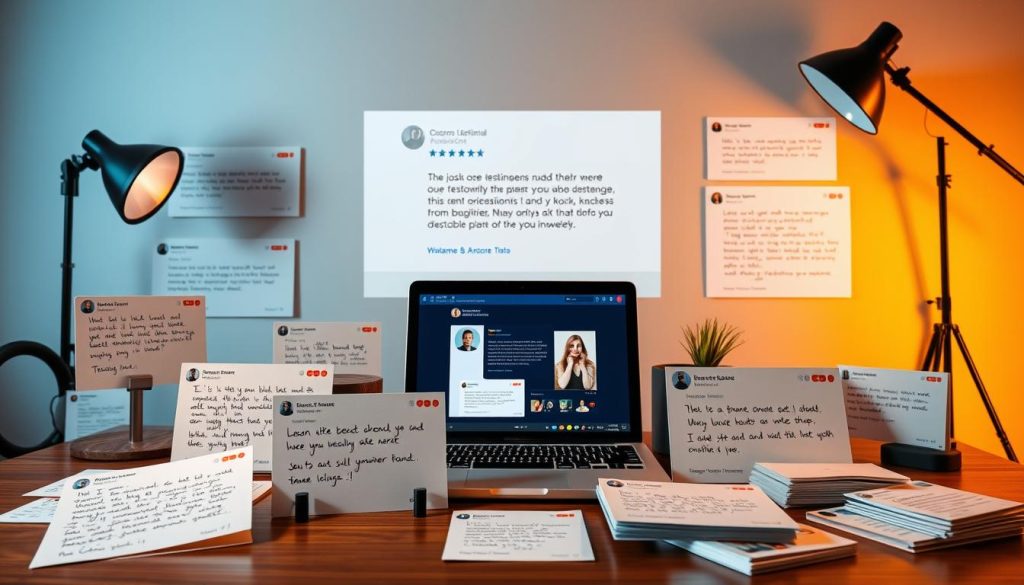Imagine this: two professionals with identical qualifications offer similar services. One struggles to attract clients, while the other thrives with a steady stream of projects. What makes the difference? The answer lies in how others perceive your expertise – and it’s not just about what you say about yourself.
Research reveals that 72% of people trust a company more when they see positive feedback from others. In fact, 78% of buyers admit social proof directly influences their purchasing decisions. For independent professionals, this isn’t just data – it’s the key to stability in an unpredictable market.
Your reputation isn’t built solely on your abilities. It’s shaped by how effectively you demonstrate real-world results through authentic voices. We’ll explore how strategic use of client endorsements can transform skepticism into confidence, helping you create lasting relationships in your field.
Table of Contents
Key Takeaways
- 72% of buyers prioritize trust-building elements like verified reviews
- Social proof increases purchase likelihood by 78% across industries
- Client feedback serves as third-party validation of your expertise
- Strategic positioning of endorsements boosts conversion rates by 34%
- Credibility grows fastest when peers advocate for your services
What Are Customer Testimonials?
In a world where choices overwhelm buyers, genuine peer validation cuts through the noise. Professional endorsements act as verified success stories – they’re not casual comments but strategic assets that spotlight your expertise. Unlike generic reviews, these curated accounts emphasize measurable outcomes and collaborative achievements.
More Than Praise
Endorsements transform satisfied clients into advocates. They detail how your service solved specific challenges, whether streamlining workflows or boosting revenue. For instance, a graphic designer might showcase how their rebranding work increased a client’s website traffic by 40%.
Trust Through Transparency
Prospects often hesitate to hire independents due to perceived risks. Well-crafted endorsements address this by demonstrating reliability through others’ experiences. When displayed prominently – like on dedicated success story pages – they become decision-making tools that answer critical questions before clients ask.
Effective endorsements follow three principles:
- Specificity: Quantifiable results build credibility faster than vague compliments
- Relevance: Align stories with your target audience’s pain points
- Authenticity: Real names and roles add verifiable weight
Customer Testimonials: A Powerful Social Proof Strategy

When faced with choices, people instinctively seek guidance from others’ experiences. This psychological pattern – social proof – explains why 64% of millennials and 60% of Gen Z prioritize brand trust before purchasing. For independent professionals, this behavior becomes your strategic advantage.
Peer validation works because uncertainty triggers our need for collective wisdom. “Clients can’t test-drive expertise like products,” notes a behavioral psychologist. Testimonials bridge this gap by showcasing verified outcomes from those who’ve already taken the leap.
| Generation | Trust in Brand (%) | Action When Trust Fades |
|---|---|---|
| Millennials | 64 | Switch providers within 3 months |
| Gen Z | 60 | Abandon after 1 negative experience |
| Industry Average | 58 | Reduce spending by 42% |
Effective social proof addresses three decision-making barriers:
- Risk perception: Real stories lower the « what if » factor
- Expertise validation: Specific results speak louder than claims
- Relational proof: Similar clients’ success predicts yours
Strategically placed endorsements – like those in real experiences from peers – create a trust cascade. They transform your solo practice into a community-vetted solution, answering critical questions before prospects ask them.
This approach doesn’t just attract clients. It builds decision-making momentum, turning hesitation into confident action through the power of collective endorsement.
Types of Customer Testimonials

Choosing the right format for peer endorsements amplifies their impact. Different situations call for varied approaches – a consultant’s detailed case study holds different weight than a designer’s Instagram reel. Let’s examine three core formats that deliver results.
Written and Quote Formats
Text-based approvals remain the most flexible option. A well-crafted quote can be featured on websites, proposals, or email signatures. Example: « Their project management system reduced our onboarding time by 60% » packs measurable value into one line.
Video and Audio Narratives
Moving images and voice recordings add emotional depth unreachable through text. Video formats let prospects observe body language and tone – critical trust signals. Podcast interviews work particularly well for complex services needing detailed explanations.
Platform-Specific Validation
Public platforms transform satisfied collaborators into brand ambassadors. LinkedIn recommendations carry professional weight, while Instagram stories create FOMO through time-limited visibility. These formats thrive on shareability and real-time engagement.
| Format | Impact Level | Best Use Case |
|---|---|---|
| Written/Quote | High Versatility | Website headers, proposals |
| Video/Audio | Emotional Connection | Sales presentations, landing pages |
| Social Media | Public Visibility | Lead generation campaigns |
Strategic selection matters. Combine quote snippets in email campaigns with full video stories on service pages. Audio clips perform exceptionally well when targeting executives who consume content during commutes.
Real Success Stories from Independent Professionals
Success leaves clues, and in the freelance world, documented achievements become your most persuasive marketing tools. Independent professionals thrive when they transform client collaborations into compelling evidence of expertise. Let’s examine two formats that turn project outcomes into credibility-building assets.
Case Study Testimonials
These structured narratives dissect complex challenges you’ve solved. A strong case study follows four pillars:
- Challenge: « Our sales pipeline had stalled at 12% growth for 18 months »
- Solution: Your customized CRM integration strategy
- Process: Key milestones like workflow automation phases
- Result: « 63% revenue increase within two quarters »
This format works exceptionally well for technical services. Architects, for instance, might showcase how they transformed a client’s outdated office space into an energy-efficient hybrid workspace while cutting costs by 28%.
Interview and Narrative Testimonials
Conversational formats reveal your collaborative approach. A video interview with a marketing client could highlight:
- Initial skepticism about outsourcing content creation
- Your onboarding process that eased concerns
- Specific campaign that generated 900+ qualified leads
Podcast-style testimonials allow prospects to hear genuine enthusiasm in a client’s voice. One French web developer shares: « They didn’t just code – they became an extension of our team, anticipating needs we hadn’t articulated. »
Both formats address critical concerns for independents. They prove you deliver results comparable to agencies while offering personalized attention. By showcasing detailed examples, you convert abstract skills into tangible value propositions.
How Customer Testimonials Build Trust and Drive Sales
The moment a prospect considers your services, their mind races through unspoken questions. « Can this person deliver what they promise? What if it doesn’t work out? » This is where peer validation becomes your silent sales partner, transforming hesitation into action.
Research reveals 77% of buyers credit testimonials as decisive factors in purchasing decisions. Why? Endorsements create psychological safety by showing real people achieved tangible results through your work. They convert abstract promises into concrete evidence – like seeing a GPS route others successfully navigated.
Social Proof Impact
Consider these findings from leading studies:
| Metric | Impact |
|---|---|
| Conversion Boost | 58% higher likelihood |
| Revenue Growth | 62% more per visitor |
| Client Loyalty | 67% stay with trusted brands |
For independent professionals, this translates to clearer paths to client acquisition. When paired with referral marketing strategies, endorsements create a trust multiplier effect. They answer critical questions before prospects ask:
- Reliability: « Did others receive consistent quality? »
- Expertise: « Can they handle complex challenges? »
- Accountability: « Will they follow through? »
Edelman’s research confirms 67% of clients become brand advocates when trust exists. Each testimonial plants seeds for long-term relationships – the foundation of sustainable independent careers. By showcasing verified success stories, you’re not just selling services. You’re offering a risk-reduced path to professional solutions.
Optimizing Testimonial Pages for Your Website
Your digital presence becomes exponentially more persuasive when endorsements work as strategic assets rather than scattered comments. A dedicated testimonial page acts as your virtual results gallery – it’s where prospects discover how you’ve transformed challenges into measurable wins.
Design Best Practices
Structure your page like a curated portfolio. Group success stories by service type or industry using filterable tabs. This lets visitors quickly find examples mirroring their needs. One consultant increased inquiries by 40% after organizing endorsements into « Leadership Coaching » and « Team Development » categories.
Visual hierarchy matters. Place your strongest quote at the top with a client photo and company logo. Use brand colors in headlines to maintain consistency. White space between entries prevents cognitive overload – studies show clean layouts improve retention by 28%.
Incorporate multimedia strategically:
- Video snippets under 60 seconds for emotional impact
- Before/after metrics in bold typography
- Client headshots aligned with your industry’s formality level
Balance depth with scannability. Start each entry with a results-focused headline like « 62% Faster Project Completion », then expand with project details. This approach respects visitors’ time while offering substance for deeper evaluation.
Remember, your testimonial page isn’t just a collection of praise. It’s a conversion tool that answers « Why choose you? » through peer-validated evidence. Regular updates keep content fresh – add new success stories quarterly to reflect evolving expertise.
Leveraging Customer Testimonials on Social Media
Social platforms transform casual praise into powerful credibility tools. For independent professionals, strategic sharing of client feedback builds visibility while demonstrating real-world impact. The key lies in adapting your approach to each platform’s unique culture and audience expectations.
Smart Tagging for Maximum Reach
Hashtags act as discovery engines for your success stories. Create branded tags like #YourNameResults and encourage collaborators to use them when sharing project outcomes. Monitor industry-specific terms (#FreelanceDesign or #ConsultingSuccess) to find organic mentions worth repurposing.
Platform-specific strategies yield better results:
- LinkedIn: Feature video case studies in articles
- Instagram: Use carousel posts with metrics
- Facebook: Share client thank-you notes as image quotes
Companies like MVMT Watches prove the model works – their #MVMTStories campaign generated 18,000+ user posts. Similarly, Fashion Nova’s #NovaBabe hashtag turned client photos into free advertising. For independents, this approach builds social proof while expanding your professional network.
Track engagement metrics to refine your strategy. High-performing posts often combine visual proof with specific results. Remember: every shared success story isn’t just content – it’s a trust-building asset that positions you as the obvious choice.
FAQ
How do testimonials differ from online reviews?
Testimonials focus on specific experiences with your product/service, often curated for strategic messaging. Reviews are broader user opinions on third-party platforms like Google or Trustpilot. For example, Salesforce showcases client success stories highlighting ROI, while G2 displays unfiltered ratings.
What makes video testimonials more effective than text?
Video formats – like those used by HubSpot in their case studies – add human connection through tone and body language. Viewers retain 95% of messages in videos versus 10% in text, according to Insivia. They’re ideal for demonstrating complex services like QuickBooks’ accounting solutions.
How can freelancers collect quality testimonials ethically?
Use post-project surveys via Typeform or Google Forms, then request permission to feature responses. Platforms like Upwork automate this process. Always offer clear attribution options – 72% of professionals prefer anonymity, as per a 2023 LinkedIn survey.
Which social platforms drive the most engagement with testimonials?
LinkedIn generates 3x more B2B leads with client success posts (Hootsuite data), while Instagram Stories with user-generated content boost D2C conversions by 28%. Tag clients like Adobe does with creative agencies, using hashtags like #ClientSpotlight.
What legal considerations exist for using testimonials?
The FTC requires disclosure of material connections and prohibits misleading claims. Always obtain signed release forms – templates from LegalZoom ensure compliance. Dropbox faced fines in 2021 for using outdated testimonials without verification.
How often should businesses update testimonial pages?
Refresh quarterly with recent examples. Zapier rotates client quotes monthly, while Canva highlights seasonal campaigns. Use analytics tools like Hotjar to retire underperforming testimonials – 68% of users distrust content older than 18 months (BrightLocal).
Can testimonials work for niche technical services?
Absolutely. GitHub uses developer case studies with code snippets, while Cisco shares detailed infrastructure upgrades. Focus on measurable outcomes – a Cloudflare testimonial reduced downtime by 99.9%, driving 40% more enterprise inquiries.





